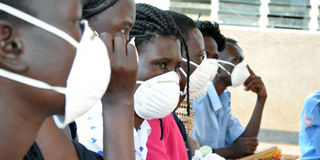Testing, drug adherence only way out of TB - experts

Treatment. Patients wait in queue to get treatment at a Gulu hospital TB ward in 2019. PHOTO/FILE.
What you need to know:
- Patients. At least 106,260 Ugandans have TB (at the current prevalence of 253/100,000 population) in a population of 42 million. An estimated 39 per cent of patients with TB never seek care, with 53 per cent of people seeking the TB treatment facing catastrophic costs that disrupt their wellbeing and that of dependents.
- Abet Tonny examines its effects, efforts to fight it and progress so far made.
Though curable, tuberculosis (TB) remains one of the world’s leading causes of mortalities, with an estimate of 1.4 million deaths in Africa annually, according to the World Health Organisation (WHO).
Each day in Uganda, TB kills 23 people and nearly 8,600 people died of TB in 2018.
According to Dr Stavia Turyahabwe, the assistant commissioner for the Uganda National TB and Leprosy Programme (NTLP).
The 2019 data from WHO, on the other hand, estimates TB deaths in Uganda at 19,000 for the year 2018.
Describing Multi-Drug Resistant (MDR) TB as the worst public health crisis and health security threat, WHO reports that 484,000 new cases of MDR TB were reported globally in 2018.
USAID Defeat TB Programme, NTLP’s major partner, reports that “forty per cent of TB patients in the central districts of Kampala, Mukono and Wakiso have MDR TB.
USAID Defeat TB Programme is the main partner of Ministry of Health’s NTLP.
“The increasing cases of MDR TB among Ugandans is a great concern, given 53 per cent of patients are already facing catastrophic costs in treating TB. And with MDR TB, the treatment costs and related burden are often higher and this spells insufferable odds for the indigent who are the most affected by TB,” the report adds.
Signs
“Whether it is drug susceptible or resistant TB, it presents with a cough. And when the cough has persisted for over two weeks, it is probably a TB and you need to visit a health facility for diagnosis,” Dr Turyahabwe says, adding that NTLP has established system for diagnosis of both types of TB.
Tuberculosis is a disease caused by bacteria that are spread from person to person through the air.
TB majorly affects the lungs, but can also affect other parts of the body such as the brain, kidneys and spinal cord.
“TB is treatable and curable. However, people with TB can die if they do not get proper treatment,” Dr Turyahabwe says.
Mr Mathew Hamilton, a US-based epidemiologist, who was contracted by Ministry of Health to facilitate the development of this patient-centered approach, says TB is not that deadly.
He further explains that the important thing on how to keep TB mortality under check is by getting tested and adhering to medications.
“There are four forms of threatening TB in Uganda and the world. There is Drug Susceptible (DS) TB, Rifampicin Resistant (RR) TB, MDR TB and Extensively Resistant (XDR) TB,” he says.
The epidemiologist, however, adds that no cases of XDR have been spotted in Uganda. Partly, he says, this could be due to lack of diagnostic equipment, which still troubles the TB fight in the country.
Drug susceptible TB is the type that can be treated with the first line drugs Isoniazid and Rifampicin – the common drugs in the country.
Mr Hamilton says Drug Resistant TB often occurs when bacteria become resistant to the drugs used to treat TB.
“This means drugs can no longer kill the TB bacteria. Rifampicin Resistant (RR) TB refers to the type which can’t be killed by Rifampicin, a first-line drug in the treatment of TB. Multi-Drug Resistant (MDR) TB, on the other hand, is when the bacteria are resistant to Rifampicin and Isoniazid plus the injectable drugs for TB,” he says.
MDR in Uganda was estimated at 2,000 in 2018. Only 26 per cent of MDR cases are reported in Uganda due to diagnosis huddles.
The DR TB is spread the same way as drug-susceptible TB, through the air from one person to another.
Stigma issues affecting TB fight
The stigma associated with TB still scares away most Ugandans from seeking proper diagnosis and treatment. The reality of having to carry the sputum bottle two or more times for laboratory investigations among other procedures to enroll in TB treatment is still unbearable in the eyes of most Ugandans.
Dr Stephen Watiti, the executive director of Community Health Alliance Uganda, says he faced a lot of stigmatisation when he confessed he had TB.
“I have suffered five times from TB and there was just so much stigma from my colleagues asking whether I had TB,” the doctor reveals.
Dr Turyahabwe says the past work of NTLP focused on determining the root cause and escalating factors for TB burden in the country.
“The 2020-2025 National Strategic Plan shall, however, focus on intervention to end TB in the country in a patient-centered approach,” she says.
The commissioner said this during a three-day national consultative meeting which attracted district health officers, chief administrative officers and dignitaries from other ministries, among foreign consultants on TB to develop the National Strategic Plan on TB and Leprosy for the next five years.
Most affected
• Men are the most affected by TB. In 2018, at least 86,000 Ugandans fell ill with TB, with 64 per cent being men. Men also contribute the largest percentage of annual TB deaths with four times more deaths than women.
• Prison inmates have some of the highest cases of TB in the country and the Multi-Drug Resistant type. The current prevalence of TB in prisons countrywide is 623 per 100,000 population compared to 253 for the whole country.
• Health workers and Urban elites.
• Karamoja Sub-region.




